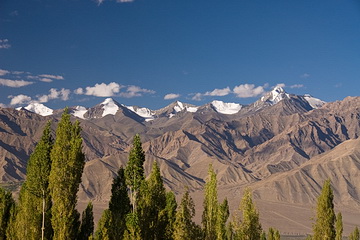Ladakh - Leh
Ladakh, das Land der hohen Pässe, gehört zum indischen Bundesstaat Jammu & Kaschmir und wird auch Westtibet genannt. Ladakh war nach seiner Öffnung für den Tourismus um 1970 nur über die Militärstrasse Srinagar-Leh und die Pässe Zoji La, Namika La und Fatu La erreichbar. Heutzutage erreicht man Leh mit dem Flugzeug oder auf dem 474 km langen Manali-Leh Highway über Rothang-, Baralacha- und Tangla Pass. Leh hat etwa 27500 Einwohner und liegt auf 3500 m Meereshöhe inmitten einer Hochgebirgswüste. Die ursprüngliche Hauptstadt Ladakhs war Shey, gegründet im 10. Jahrhundert. Erst unter der Regentschaft des Königs Senge Namgyal im 17. Jahrhundert übernahm Leh diese Rolle.
Ladakh - the land of high passes - belongs to the Indian State of Jammu and Kashmere and is also known as Western Tibet. Before it was opened for tourism in 1970 the only way to get there was the military road from Srinagar to Leh across the passes Zoji La, Namika La und Fatu La. Today Leh can be reached by plane as well as on the 474 km Manali - Leh Highway. The city with a population of about 27.500 lies in a mountain desert at an altitude of roughly 3.500 m. Under the regency of King Senge Namgyal in the 17th century Leh became capital of Ladakh taking over the part from Shey which played this role for about 700 years.
Flug von Delhi nach Leh über die etwa 6000 m hohen Zanskar Berge.
The 6.000 m peaks of the Zanskar range taken on the flight from Delhi to Leh.
Blick von der Shanti Stupa auf Leh und die Berge der Stok Gruppe. Der Stok Kangri (6130 m - ganz rechts), früher Parcha Kangri, ist der einzige Sechstausender dieser Gruppe. Der Bau der Shanti Stupa wurde 1983 begonnen und 1991 fertiggestellt. Die Idee sogenannte Friedenspagoden zu bauen, stammt von einer japanischen buddhistischen Mönchsgemeinschaft und wurde von ihr und Ladakhis realisiert.
View from Shanti Stupa towards Leh and the Stok mountains with Stok Kangri (former Parcha Kangri - 6.130 m) the only 6.000 m peak of this group. The construction of Shanti Stupa was started in 1983 and finished in 1991. The idea of building so-called 'peace-pagoda' originates from a japanese buddhist confraternity who realised it together with Ladakhi people.
Tempelhügel bei Leh.
A temple hill near Leh.
Namgyal Tsemo Gompa oberhalb des Königspalastes von Leh mit dem Maitreya Tempel. Die Anlage wurde im Jahr 1430 von König Tashi Namgyal erbaut. Maitreya ist der zukünftige Buddha.
Namgyal Tsemo Gompa and the Maitreya temple above the Royal Palace of Leh was built in the year 1430 by King Tashi Namgyal. Maitreya is regarded as the future Buddha.
Gegenüber unserem ersten Besuch von Leh 1979 hat sich das alte Leh gewaltig verändert und vergrößert.
Compared to our first visit in 1979 Leh has changed and grown remarkably.
Der Chokhang Vihara Tempel wurde 1980 vom Dalai Lama eingeweiht. Die 89 Gebetstrommeln sollen über 150 Millionen Mani Mantras für das Wohlergehen und die Erleuchung aller Menschen enthalten.
The Chokhang Vihara Temple was inaugurated by the Dalai Lama in 1980. The 89 prayer wheels are supposed to contain 150 million mantras for the welfare and enlightenment of all human beings.
Das Kloster Sankar liegt etwa 3 Kilometer vom Zentrum Lehs entfernt und gehört zum Gelugpa Kloster Spituk.
Sankar monastery is located about 3 kms away from the center of Leh and belongs to the Gelugpa monastery of Spituk.
Der Königspalast von Leh.
The Royal Palace of Leh.
